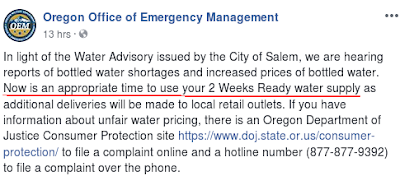#13,343
Yesterday Oregon Emergency Management officials issued the above advice after the local water supply was contaminated by a toxic algae bloom, making tap water unsafe to drink for children, the immunocompromised, and others.
Within hours, store shelves were stripped of bottled water and other supplies (see AP story & photo Cryptic emergency alert panics Oregon city's residents), as thousands of Oregonians found themselves caught without even the most basic of supplies; drinking water.This crisis, and the public's reaction, are almost identical to what we've seen in the past along the shores of Lake Erie (see Water, Water, Everywhere But Not A Drop To Drink).
Toxic algae - which is present in small quantities in most fresh water lakes - blooms during the summer (when temps are warm, sunlight is abundant, and winds are generally light) – particularly when fed by nutrient rich fertilizer (or other pollutant) run offs.
The advice to the public to use their `2 Weeks Ready water supplies' to help get through this crisis is, of course, of little help to those who failed to prepare in advance, but may spur them on to becoming better prepared for the next emergency.The operative word being `may', because as I recounted last year during the approach of hurricane Irma to Florida - a state hit with some regularity by major storms - store shelves had been stripped of bottled water, flashlights, batteries, radios, and other hurricane supplies a full 5 days before the storm arrived.
Despite the strong likelihood of a hurricanes, and yearly preparedness campaigns, people - for reasons that baffle me - rarely prepare for an emergency - even in Hurricane Alley.While Oregonians have nothing to fear from hurricanes, they all live in a seismically active region - one that could produce a much larger earthquake and tsunami than the San Andreas fault in California.
It's a disaster scenario we've looked at several times in the past - including in 2011's Just A Matter Of Time, and 2015's OSU: Pragmatic Action - Not Fatalism - In Order To Survive The `Big One’ - and one that FEMA and local Emergency Management take very seriously (see FEMA: Cascadia Rising 2016).
For this reason - and for lesser emergencies - the Oregon Office Of Emergency Management promotes a 2 Weeks Ready campaign. Note, the goal is for citizens to be prepared to be on their own for a minimum of two weeks following a disaster.
2 Weeks ReadyA large earthquake and tsunami will demolish parts of western Oregon and leave much of the area's transportation routes destroyed. Oregonians will need to count on each other in the community, in the workplace, and at home in order to be safe until help can arrive. This is just one reason why OEM encourages people to be prepared to be on their own for a minimum of two weeks following a disaster. We've created a wide variety of two weeks ready resources, and recently launched a series of fun and friendly animated videos.
It doesn't take a mega-earthquake, Cat 5 hurricane, asteroid strike, or pandemic to ruin your entire day. Infrastructures fail and floods, fires, even industrial accidents can disrupt your daily supply of goods and services.
If you aren't prepared in advance to handle a few days without potable (or any) tap water, or to endure an extended power outage (summer or winter), you - and your loved ones - are unlikely to fare very well during a major disaster.While you may not live along the coastline, or in tornado alley, or in a seismically active region of the country, there is probably not a speck of ground where you can't be impacted by a disaster. Some places are higher risk than others, but no place is immune.
While FEMA and other agencies urge at least 72 hours worth of preparedness, in truth, if you have less than 10 to 14 days worth of food, water and supplies, you and your family are in for a very rough time should a major disaster strike.Salem Oregon's water crisis will likely be short-lived, and no one is apt to die for lack of water. But the next disaster there - or anyplace else on the planet - could come with little or no warning, and be both prolonged and deadly.
You need to ask yourself . . . if a disaster struck your community today, do you already have?
- A battery operated NWS Emergency Radio to find out what was going on, and to get vital instructions from emergency officials
- A decent first-aid kit, so that you can treat injuries
- Enough non-perishable food and water on hand to feed and hydrate your family (including pets) for the duration
- A way to provide light when the grid is down.
- A way to cook safely without electricity
- A way to purify or filter water
- A way to stay cool (fans) or warm when the power is out.
- A small supply of cash to use in case credit/debit machines are not working
- An emergency plan, including meeting places, emergency out-of-state contact numbers, a disaster buddy, and in case you must evacuate, a bug-out bag and a predetermined place to go.
- Spare supply of essential prescription medicines that you or your family may need
- A way to entertain yourself, or your kids, during a prolonged blackout
You may also wish to revisit some of my preparedness blogs:
When 72 Hours Isn’t Enough
In An Emergency, Who Has Your Back?
#NatlPrep: The Gift Of Preparedness 2017
